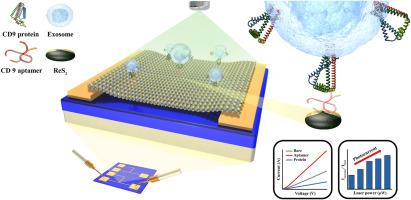Light-induced field effect transistor-based biosensor consisted of aptamer and ReS2 single crystal layer for exosome detection
IF 10.2
1区 医学
Q1 ENGINEERING, BIOMEDICAL
引用次数: 0
Abstract
Field-effect transistor (FET)-based biosensors are promising platforms for point-of-care diagnostics because of their low power requirements, miniaturization capabilities, and high sensitivity toward charged biomolecules. In particular, light-induced FET (L-FET) facilitate photo-generated carrier signal amplification using an external light source, enabling high detection sensitivity from minimal sample volumes. This study proposed the first L-FET biosensor that integrated single-crystal ReS2 with biomolecules to achieve effective photo-generated carrier signal amplification. ReS2 maintains its single-layer electronic characteristics even in bulk, thus minimizing signal variability across devices. The ReS2 current channel is established via mechanical exfoliation onto Au electrodes on a SiO2 substrate, and photo-generated carrier amplification was induced using a photoconductive effect via laser illumination. Signal variation was assessed using 2-channel I-V measurements following the biomolecular complex formation. The results demonstrated an approximately two times increase in the photo-generated carrier amplification ratio. The detection range for exosomes targeting CD9 protein within human serum was determined to be 102–107 exosomes/mL, with a limit of detection (LOD) of 9.79 × 103 exosomes/mL, thereby demonstrating stable detection even at low concentrations. The proposed L-FET biosensor design which incorporated direct bioconjugation with semiconductor devices offered a fundamental advance for early diagnostic platforms. The device's simplified architecture and signal amplification mechanism exhibited advantages for large-scale production, enhancing its commercial viability, and highlighting its potential to impact the evolution of next-generation medical diagnostic technologies enormously. This study introduced a new paradigm for FET-based biosensors, positioning this platform as a candidate for diverse biomarker detection and early disease diagnostic applications.

基于光致场效应晶体管的生物传感器由适体和ReS2单晶层组成,用于外泌体检测
基于场效应晶体管(FET)的生物传感器因其低功耗要求、小型化能力和对带电生物分子的高灵敏度而成为有前途的即时诊断平台。特别是,光致FET (L-FET)可以利用外部光源放大光产生的载流子信号,从而在最小的样品体积下实现高检测灵敏度。本研究提出了首个将单晶ReS2与生物分子集成的L-FET生物传感器,实现了有效的光生载流子信号放大。ReS2即使在批量生产时也保持其单层电子特性,从而最大限度地减少了设备之间的信号可变性。通过机械剥离在SiO2衬底上的Au电极上建立ReS2电流通道,并利用激光照明的光导效应诱导光生成载流子放大。利用生物分子复合物形成后的2通道I-V测量来评估信号变化。结果表明,光产生的载流子放大比增加了大约两倍。测定了人血清中靶向CD9蛋白的外泌体的检测范围为102 ~ 107外泌体/mL,检测限(LOD)为9.79 × 103外泌体/mL,即使在低浓度下也能稳定检测。提出的L-FET生物传感器设计结合了与半导体器件的直接生物偶联,为早期诊断平台提供了根本性的进步。该设备的简化架构和信号放大机制显示出大规模生产的优势,提高了其商业可行性,并突出了其对下一代医疗诊断技术发展的巨大影响。该研究为基于fet的生物传感器引入了一种新的范例,将该平台定位为多种生物标志物检测和早期疾病诊断应用的候选平台。
本文章由计算机程序翻译,如有差异,请以英文原文为准。
求助全文
约1分钟内获得全文
求助全文
来源期刊

Materials Today Bio
Multiple-
CiteScore
8.30
自引率
4.90%
发文量
303
审稿时长
30 days
期刊介绍:
Materials Today Bio is a multidisciplinary journal that specializes in the intersection between biology and materials science, chemistry, physics, engineering, and medicine. It covers various aspects such as the design and assembly of new structures, their interaction with biological systems, functionalization, bioimaging, therapies, and diagnostics in healthcare. The journal aims to showcase the most significant advancements and discoveries in this field. As part of the Materials Today family, Materials Today Bio provides rigorous peer review, quick decision-making, and high visibility for authors. It is indexed in Scopus, PubMed Central, Emerging Sources, Citation Index (ESCI), and Directory of Open Access Journals (DOAJ).
 求助内容:
求助内容: 应助结果提醒方式:
应助结果提醒方式:


